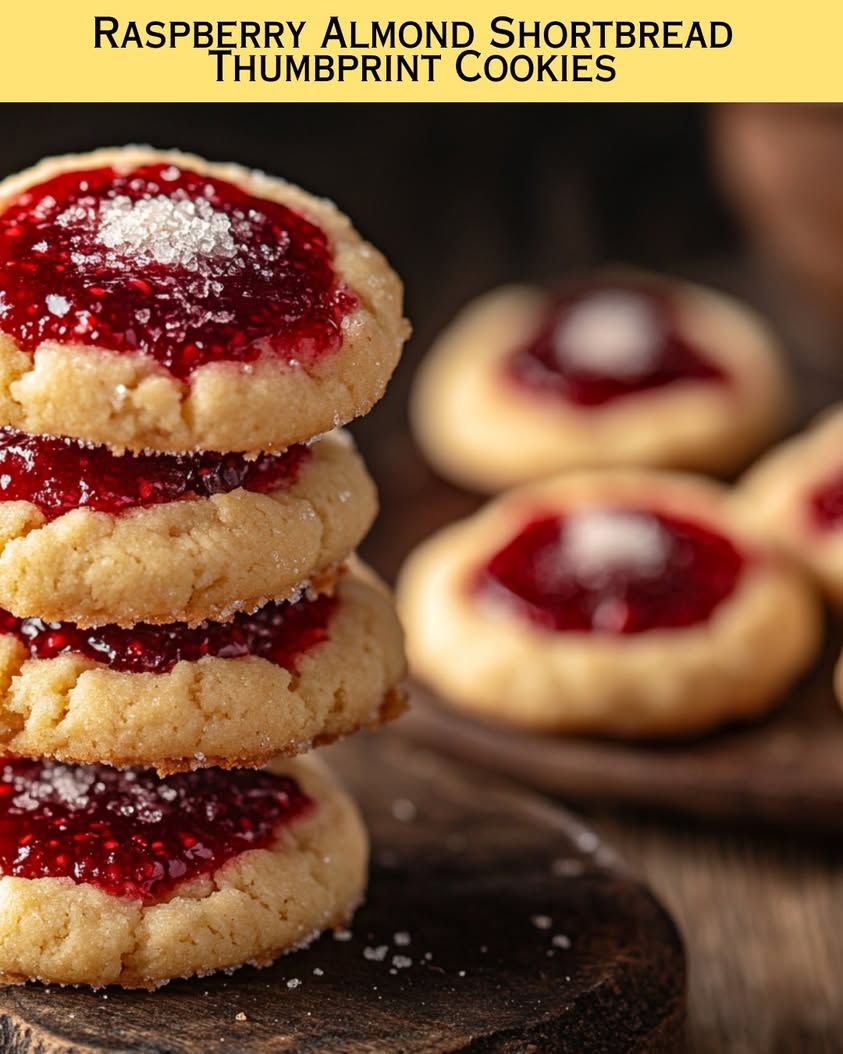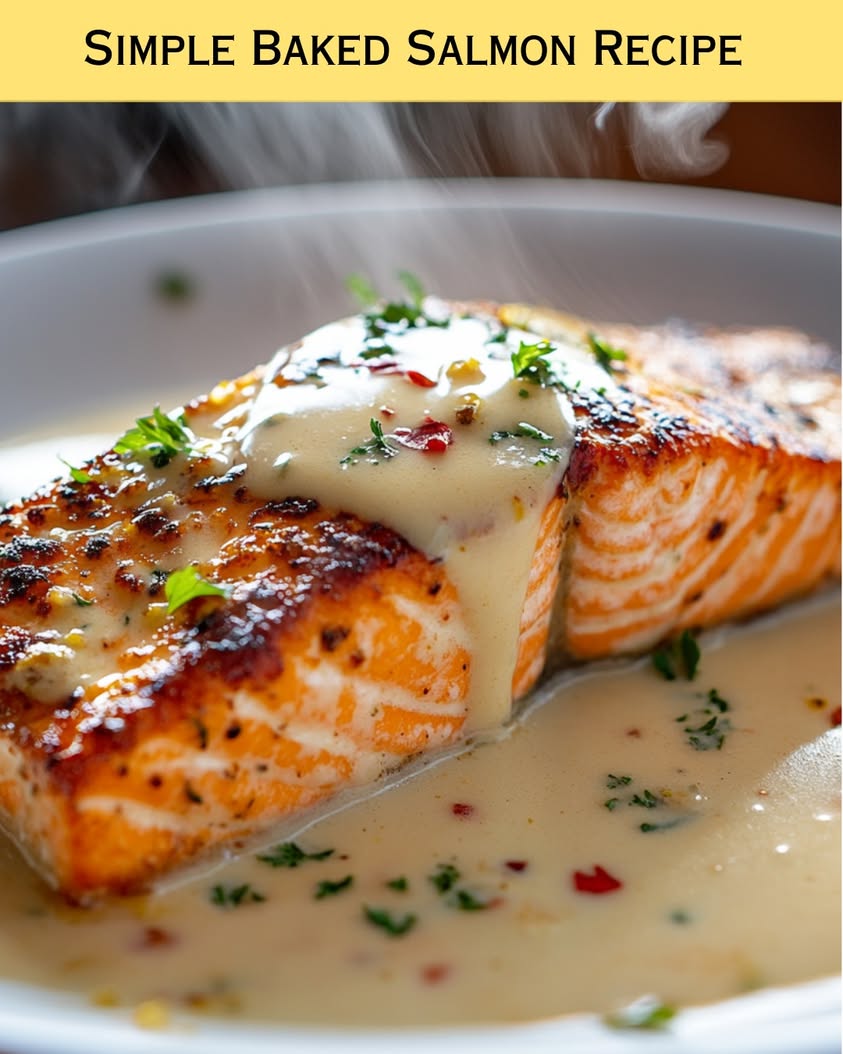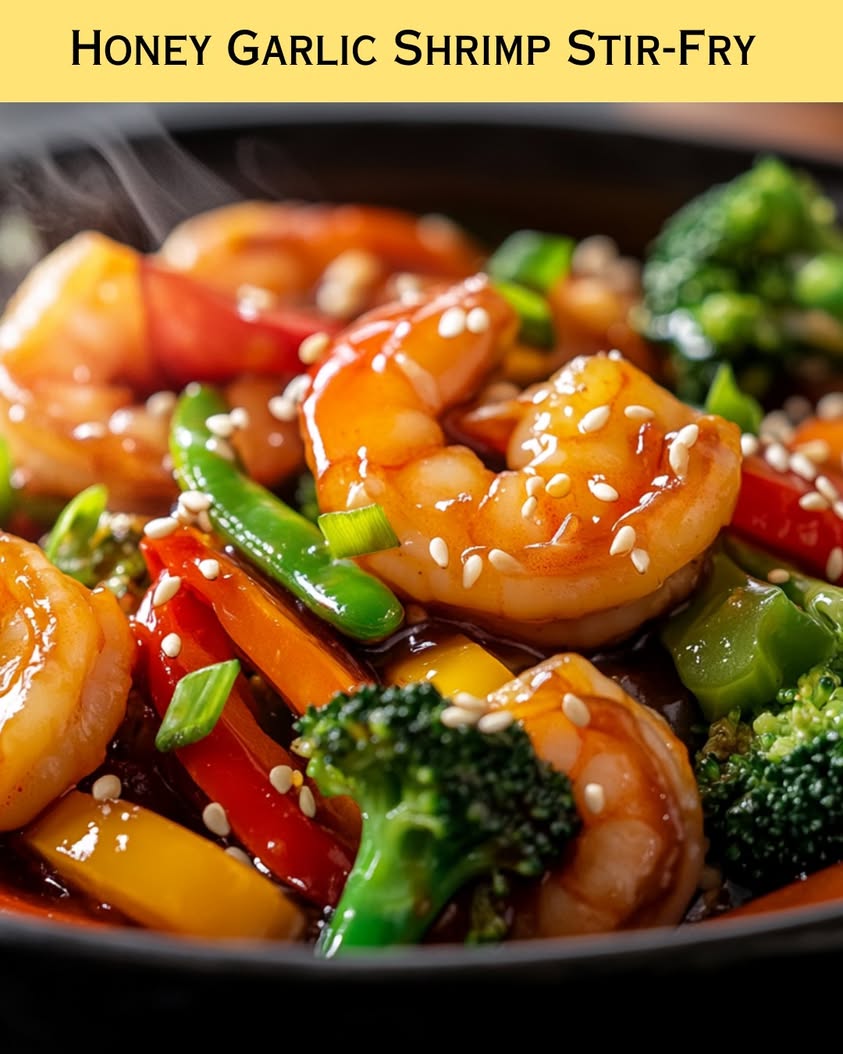Delicious Raspberry Almond Shortbread Thumbprint Cookies: A Sweet Treat to Savor
The comforting blend of buttery shortbread and the sweetness of ripe raspberries come together beautifully in these Raspberry Almond Shortbread Thumbprint Cookies. This delightful treat, infused with almond flavor, offers a melt-in-your-mouth experience that will remind you of cherished moments spent in the kitchen. Whether you are hosting a gathering, enjoying a quiet afternoon, or simply indulging your sweet tooth, these cookies promise to be the highlight of the day.
With their stunning appearance and delicious taste, Raspberry Almond Shortbread Thumbprint Cookies not only delight the taste buds but also create a feast for the eyes. Each cookie is a tiny work of art, with vibrant raspberry filling nestled into a rich, golden-brown shortbread base. The combination of almond extract and fresh raspberry preserves adds depth and sophistication, ensuring that each bite is both satisfying and comforting.
Quick Recipe Highlights
- Flavor Profile: These cookies expertly balance the rich, buttery flavor of almond and the tart sweetness of fresh raspberries, creating an irresistible taste.
- Texture: The cookies have a delicate crumb that melts in your mouth, combined with a slightly chewy center from the raspberry filling.
- Aroma: The aromatic notes of toasted almonds complement the fruity fragrance of the raspberries, making your kitchen smell heavenly while baking.
- Visual Appeal: The contrast of the golden shortbread and vibrant raspberry filling makes these cookies not only delicious but also visually stunning.
- Skill Level Needed: This recipe is beginner-friendly, requiring basic baking skills like mixing, shaping, and baking.
- Special Equipment: A baking sheet, a mixing bowl, and a small round measuring spoon (for thumbprints) are all you need.
Recipe Overview
- Difficulty Level: These Raspberry Almond Shortbread Thumbprint Cookies are classified as easy, making them perfect for both novice and experienced bakers.
- Category: These cookies fit well within dessert or snack categories, ideal to serve alongside afternoon tea or as party treats.
- Cuisine: This recipe embraces both traditional European baking techniques and modern American flavors, showcasing the popularity of thumbprint cookies.
- Cost: Ingredients such as butter, flour, and raspberries are relatively inexpensive, making it a budget-friendly option for all occasions.
- Season: Enjoy these cookies year-round, but they shine especially in the summer when raspberries are in season.
- Occasion: Great for holiday baking, birthday celebrations, or simply as a sweet treat to share with friends.
Why You’ll Love This Recipe
The combination of taste and texture is what makes Raspberry Almond Shortbread Thumbprint Cookies simply irresistible. The buttery shortbread base provides a satisfying crunch that gives way to a rich, chewy center filled with raspberry goodness. This perfect blend is sure to impress your taste buds while inviting nostalgia for simpler baking days.
Convenience is another reason to love this recipe. With just a few simple ingredients and easy instructions, you can whip up a batch in no time at all. The short preparation time and minimal cleanup make it an accessible recipe for busy bakers or those new to the kitchen. You’ll have delicious cookies ready to serve in just 35 minutes!
On top of their delightful flavors and ease of preparation, these cookies carry nutritional benefits as well. Almonds are packed with healthy fats and protein, and fresh raspberries provide antioxidants and vitamins, making these cookies a more wholesome treat than typical dessert options.
Socially, these cookies are perfect for entertaining and bring joy to any gathering. They are delightful to share with friends and family and serve as fantastic conversation starters. Watch as everyone gathers around your plateful of cookies, eager for a taste!
Finally, Raspberry Almond Shortbread Thumbprint Cookies are especially cost-effective. You likely have many of the ingredients already on hand, making it affordable to indulge in homemade baking while delighting your loved ones with freshly baked treats.
Historical Background and Cultural Significance
The origin of thumbprint cookies is thought to date back to Eastern European culinary traditions, where various cultures created their unique versions using different fillings. The name “thumbprint” is derived from the traditional technique of using the thumb to create a well for the filling, quickly becoming a favorite baking choice in many households.
Culturally, these cookies hold a significant place during festive occasions. Traditionally, thumbprint cookies were made as gifts to celebrate holidays and special events, representing goodwill and community spirit. These small rounds of goodness have evolved to become a beloved treat across many cultures, often adapted with local ingredients and flavors.
The recipe itself has undergone various transformations throughout the years. From basic sugar or butter cookies, the inclusion of fruit preserves and nuts has propelled thumbprint cookies to a new level of culinary creativity, making them a staple in contemporary baking.
Today, regional variations of thumbprint cookies abound, showcasing the diverse flavors and techniques of different culinary traditions. From chocolate to jam fillings, bakers continue to experiment, making this a timeless dessert that inspires countless adaptations while honoring its roots.
Ingredient Deep Dive
Butter: Butter serves as the heart of these cookies, contributing to their rich flavor and crumbly texture. Historically, butter has been an essential ingredient in many baking traditions, allowing for a tender outcome that is harder to achieve with other fats. For the best results, use high-quality, unsalted butter that has been softened to room temperature.
Raspberries: Fresh raspberries not only bring vibrant color and sweetness to the cookies but also provide essential nutrients. They are low in calories and packed with vitamins like C, K, and minerals. When selecting raspberries, choose ones that are plump and bright without signs of mold. Store them in the refrigerator and consume within a few days for optimal freshness.
Almond Extract: Almond extract adds a delightful nutty flavor that perfectly complements the raspberry filling. This extract has its roots in Mediterranean cuisine and is widely used in many baked goods. When selecting almond extract, look for pure extracts over imitation, as they provide a more robust and authentic flavor. Store it in a cool, dark place to maintain its potency.
Flour: All-purpose flour is a fundamental ingredient that provides structure to cookies. Originally a staple pantry item, it’s been used in baking for centuries across various cultures. For the best texture, be sure to measure the flour accurately and sift it if necessary. In an airtight container, it can be stored in a cool, dry area for several months.
Common Mistakes to Avoid
- Overmixing the Dough: While it may be tempting to mix the dough longer for a smoother consistency, overmixing can lead to tough cookies. Mix until just combined to achieve the perfect texture.
- Insufficient Chilling Time: Skipping the chilling step can lead to cookies that spread too much during baking. Chilling will help firm up the butter and maintain the desired shape.
- Uneven Sizes: Not rolling the dough into uniform sizes can result in uneven baking. Using a cookie scoop will help ensure that each cookie bakes evenly.
- Filling Too Early: Adding the raspberry filling before the cookies are fully baked can lead to messy results. Fill them just before the final few minutes of baking.
- Ignoring Oven Temperature: Baking at the wrong temperature can seriously affect cookie texture and cook time. Always preheat your oven and have an oven thermometer handy.
- Not Using Quality Ingredients: While saving on cheap ingredients may seem beneficial, high-quality butter and flavorings yield superior results. Investing in good ingredients pays off in taste.
- Using Stale Ingredients: Check the expiration dates on your baking ingredients regularly. Using stale ingredients can lead to undesirable flavors and textures.
- Skipping the Taste Test: Always taste the dough before baking to ensure it meets your flavor expectations. A quick taste can help adjust sweetness levels before baking!
Essential Techniques
Creasting Shortbread Dough: Mastering the technique of creaming butter and sugar is crucial for creating light, airy cookies. This step traps air, allowing the cookies to rise during baking. Aim for a light and fluffy mixture before adding other ingredients, and avoid overmixing once flour is included.
Creating Thumbprints: The technique of making thumbprints is essential to this recipe. After rolling the dough into balls, gently press your thumb into the center to create a well. This well not only holds the raspberry filling but also ensures an even bake. Be careful not to press too hard, as the dough should maintain its shape while creating enough space for the filling.
Pro Tips for Perfect Raspberry Almond Shortbread Thumbprint Cookies
– Use room temperature ingredients for even mixing and better incorporation of flavors.
– Chill the cookie dough for at least 30 minutes before rolling; this helps maintain the shape.
– Opt for high-quality raspberry preserves for a superior flavor experience; homemade preserves can elevate the result.
– Rotate the baking sheet midway through baking for even browning.
– Store cookies in an airtight container to maintain freshness; they can also be frozen for later enjoyment.
– Consider garnishing with slivered almonds after baking for a lovely texture and aesthetic.
Variations and Adaptations
– For a seasonal touch, swap out raspberries for other fruits like strawberries or blueberries.
– Create a festive twist by adding spices like cinnamon or cardamom.
– Substitute gluten-free flour for a gluten-free version; ensure the raspberry preserves are also gluten-free.
– Incorporate chocolate chips for an extra layer of flavor.
– Experiment with different nuts; pecans or walnuts can change the texture beautifully.
– Serve alongside a scoop of vanilla ice cream for a delicious dessert fusion.
Serving and Presentation Guide
To present your Raspberry Almond Shortbread Thumbprint Cookies beautifully, consider using a decorative platter. Arrange the cookies with a sprinkle of powdered sugar and a few fresh raspberries for color contrast. For a garnish, dust lightly with confectioner’s sugar or drizzle with melted chocolate for added appeal. Serve them warm or at room temperature, and provide a small dish of fresh raspberries on the side for an inviting touch.
Wine and Beverage Pairing
Pair your Raspberry Almond Shortbread Thumbprint Cookies with a light white wine, such as Riesling, which complements the sweet and tart elements of the raspberry filling perfectly. For those who prefer a non-alcoholic option, a refreshing sparkling lemonade or iced tea with mint would be delightful. If you enjoy coffee, a medium roast blends well with the buttery notes of the cookies, elevating the entire tasting experience.
Storage and Shelf Life
Raspberry Almond Shortbread Thumbprint Cookies can be stored in an airtight container at room temperature for up to one week. For longer storage, freeze the cookies individually on a baking sheet until solid, then place them in a freezer-safe bag. Properly stored, they can last for up to three months in the freezer. When ready to enjoy, thaw at room temperature and consider refreshing them briefly in the oven to regain their texture.
Make Ahead Strategies
You can prepare the dough for Raspberry Almond Shortbread Thumbprint Cookies a day in advance. Simply wrap it in plastic wrap and refrigerate until you’re ready to bake. The dough can be rolled into balls and kept in the fridge or freezer, so you can bake fresh cookies whenever you want. Baking in batches is a great way to have a steady supply of delicious cookies on hand for gatherings or family treats.
Scaling Instructions
To halve the recipe for a smaller batch, simply divide each ingredient in half and adjust the baking time slightly if necessary. For doubling or tripling the recipe, you may need additional baking sheets and space in your oven to accommodate the volume. Additionally, be mindful of how the increased mass affects the baking time; larger batches may need a few extra minutes. Store any excess dough before baking in the refrigerator to maintain its freshness.
Nutritional Deep Dive
These Raspberry Almond Shortbread Thumbprint Cookies offer a delectable treat while also incorporating beneficial ingredients. Typical macros per cookie include around 120 calories, with a balance of healthy fats from almond ingredients and carbohydrates from flour. The vitamins present in raspberries can aid in supporting a healthy immune system. For those watching their portions, you can easily make mini versions of these cookies, allowing for a delicious indulgence without overdoing it.
Dietary Adaptations
For a gluten-free adaptation, substitute regular flour with a gluten-free all-purpose blend. To make them dairy-free or vegan, use a dairy-free butter alternative and a flax egg for binding. For a low-carb option, consider almond flour instead of traditional flour; however, this may change the texture slightly. These variations allow everyone to enjoy these delightful cookies, regardless of dietary restrictions.
Troubleshooting Guide
If your cookies turn out too dry, check your flour measurements and ensure you’re not overmixing. To fix flat cookies, make sure you chill your dough adequately and check that your butter is correctly measured. If your thumbprints aren’t holding a shape, a gentle press is all that’s necessary; too hard can deform the cookie. When fillings leak out during baking, create a more defined thumbprint well before filling, ensuring it holds the preserves correctly.
Recipe Success Stories
Share your experience with Raspberry Almond Shortbread Thumbprint Cookies! From personal family traditions to sweet memories created during baking, each story is unique. Consider photographing your cookie creations and sharing them with fellow baking enthusiasts online. Your success stories may inspire others, and suggestions on flavor or ingredient adaptations can foster a sense of community and creativity in the kitchen.
Frequently Asked Questions
Can I use frozen raspberries for the filling?
Yes, you can use frozen raspberries, but ensure they are thawed and excess moisture has been drained before using them as filling to prevent a soggy dough.
How can I prevent the cookies from spreading too much?
To prevent spreading, ensure the dough is thoroughly chilled before baking. Additionally, use cold butter and work quickly to maintain its temperature.
Can I replace the almond extract with another flavor?
Certainly! Feel free to substitute almond extract with vanilla or hazelnut extract for a different but equally delicious flavor profile.
What’s the best way to store leftover cookies?
Store the cookies in an airtight container at room temperature for up to a week, or freeze them for longer storage. Just ensure they are fully cooled before storage.
Can I make the dough ahead of time?
Yes! You can prepare the dough in advance and refrigerate it for up to 24 hours before baking. Just allow it to soften slightly at room temperature before rolling.
What can I use instead of butter?
Dairy-free butter or coconut oil can be excellent alternatives for butter. However, keep in mind it may slightly alter the flavor and texture.
Are these cookies suitable for freezing?
Absolutely! These cookies freeze beautifully. Lay them flat on a baking sheet, freeze till solid, then store them in a freezer-safe bag for up to three months.
How do I know when the cookies are done baking?
Look for a light golden color on the edges, and the center should appear set but slightly soft. They will continue to firm up as they cool.
Why did my cookies turn out too soft?
Soft cookies can indicate underbaking; always give them a few extra minutes in the oven if they’re too soft. Additionally, check your oven temperature with a thermometer for accuracy.
Do I need to remove the cookies from the baking sheet immediately?
Allow the cookies to cool on the baking sheet for about 5 minutes before transferring them to a wire rack. This helps avoid breaking as they set.
Additional Resources
Looking for more scrumptious recipes? Check out our collection of related baked goods, from quick bread to delightful cakes! We also offer technique guides to improve your baking skills and ingredient information to enhance your knowledge of pantry staples. If you’re interested in seasonal variations, consider exploring fruit-themed desserts to celebrate each season’s bounty.
Join the Conversation
We love hearing from our readers! Share your baking experiences, tips, and variations on this Raspberry Almond Shortbread Thumbprint Cookies recipe with us on social media. Don’t forget to upload photos of your cookie masterpieces – we’re excited to see your creativity in action! Engage with others in the community by commenting on shared stories or offering feedback on their delicious treats.
The Recipe
Raspberry Almond Shortbread Thumbprint Cookies
Serves: 24 cookies
Prep Time: 20 mins
Cook Time: 15 mins
Total Time: 35 mins
Kitchen Equipment Needed
- Baking sheet
- Mixing bowl
- Measuring cups and spoons
- Cookie scoop or spoon
- Cooling rack
Ingredients
- 1 cup unsalted butter, softened
- 1/2 cup powdered sugar
- 1 tsp almond extract
- 2 cups all-purpose flour
- 1/4 tsp salt
- 1 cup raspberry preserves
- Optional sliced almonds for garnish
Directions
- Preheat your oven to 350°F (175°C) and line a baking sheet with parchment paper.
- In a mixing bowl, cream together the softened butter and powdered sugar until light and fluffy.
- Add almond extract, flour, and salt, swirling gently until just combined into a dough.
- Chill the dough for about 30 minutes in the refrigerator to firm up.
- Once chilled, roll the dough into small balls (about 1 inch in diameter) and place them on the prepared baking sheet.
- Using your thumb, press a well into the center of each cookie ball.
- Fill each thumbprint carefully with raspberry preserves, about 1/2 teaspoon each.
- Bake for 12-15 minutes or until lightly golden around the edges.
- Remove from the oven and let cool on the baking sheet for 5 minutes before transferring to a wire rack.
Recipe Notes
- For added crunch, sprinkle sliced almonds on the cookies right after baking.
- Store any leftovers in an airtight container at room temperature for up to a week.
- Cookies can be frozen; seal them in a freezer-safe container for up to three months.




